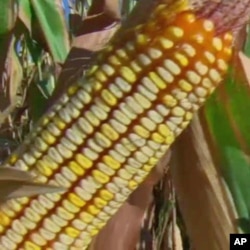Maize crops withered in Texas this year in a season of record-breaking heat and drought. In the Texas High Plains region, crops struggled to survive on as little as one-tenth of the normal rainfall.
“Matter of fact, it may be the all-time driest year on record,” says Thomas Marek, an irrigation expert with Texas A&M University.
Experts warn that climate change is likely to threaten world food supplies as temperature extremes cut harvests of important food crops. Scientists are working to develop new varieties that are adapted to a changing climate.
So, while this was a terrible year for farmers, for Marek and his colleagues, it was just about perfect. At a research station an hour north of Amarillo, they work to prepare farmers for hotter, drier years ahead.
“It’s going to become more and more important," says Wenwei Xu, who leads the team’s maize breeding efforts. "Because, with climate change, cold places are getting colder, warm places are getting hotter. When it gets hot, you get drought.”
Hot weather and drought turn maize plants brown. That means the end of photosynthesis, which is how maize plants turn sunlight into starchy kernels.
But Xu’s colleague, Qingwu Xue, identified genes that help some tropical maize varieties stay green longer under these conditions.
“If they stay green longer, they can photosynthesize longer," says Xue. "Once they photosynthesize longer, they can fill their grain for a longer time.”
Plants that stay green longer produce bigger kernels in a drought year. The team mated maize with the stay-green genes with other high-producing varieties to find offspring with the best of both. They used traditional breeding rather than genetic engineering, which is more heavily regulated.
But finding that perfect maize variety is not an easy task.
“There’s no free rides in this," Marek says. "So, when you put a gene in or a characteristic in, you might take a little bit off the maximum production. But then, we don’t know what Mother Nature’s going to hold for that year.”
This year, when Mother Nature was not kind to conventional maize, stay-green varieties produced bigger ears with more kernels than those without the trait. It’s a promising step, but it will take more work before these drought-hardy seeds are available for farmers. When they are, the benefits will reach far beyond the United States, Xu says.
“Once we discover this drought-tolerant corn, this germplasm can be used throughout the world.”
And the world will need it as climate change makes it harder to feed a growing population.



















